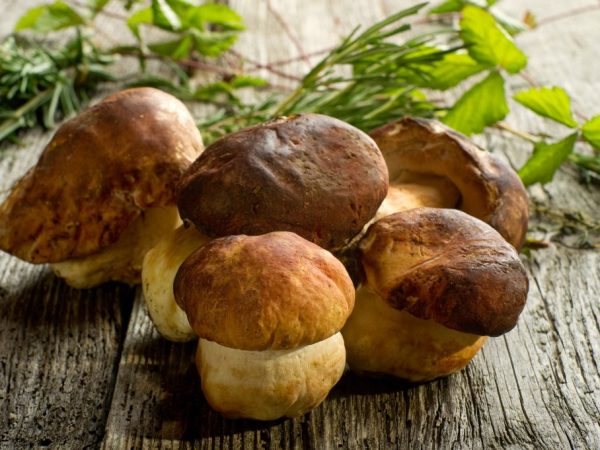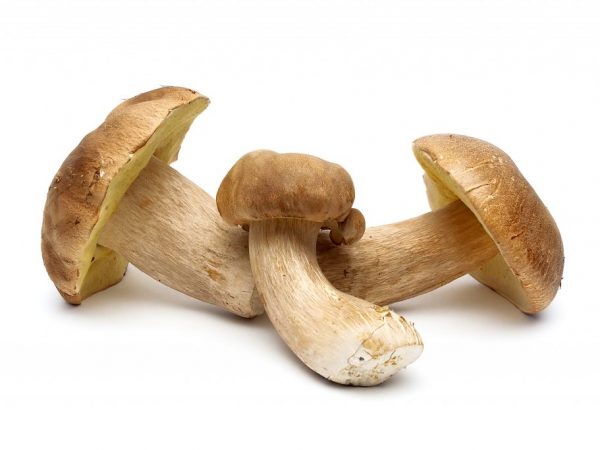Growing conditions for porcini mushrooms
Golden autumn is the season of mushroom picking. The most popular among lovers of "quiet hunting" is the porcini mushroom. The conditions for the growth of porcini mushrooms have certain nuances. This normal development of the species requires the correct temperature regime, moisture in the surface layers of the soil and good lighting.

Growing conditions for porcini mushrooms
Humidity
The rapid growth rate of the mycelium and the development of mycelium is provided by a moisture content of 60%. If, after rainy weather, a prolonged drought sets in, and porcini mushrooms grow poorly at low air humidity and often dry out. This is due to the fact that the fruit body of this species has no protection against evaporation. The main places of localization of the porcini mushroom are areas with moss and forest litter. In a humid and sun-protected environment, they will grow rapidly.
Temperature
The second important indicator of intensive growth is temperature. Mycelium grows even at low temperatures - about 8 ° C, but it develops slowly in such conditions.
The optimum temperature varies between 18-28 ° C. Mushrooms grow rapidly during the rainy season and warm weather. During this period, the duration of their growth can be 1 month.
During this period, porcini mushrooms reach truly gigantic sizes - the length of the leg is 10-12 cm, the diameter of the hat is 16-19 cm. The average weight of such specimens is 0.2-0.3 kg. The life cycle is about two weeks. First, the leg fades, after a couple of days the cap turns black. When spores appear, the fruiting bodies of adult specimens age and disintegrate.
Getting good yields depends on how well the mushroom picking is done. Boletus appear in the same place for several years in a row, if the mushroom picker leaves the lower part of the leg in the ground when cutting. Next year there will be no need to look for new mushroom places, a good harvest is obtained from last year's mycelium.
Mushroom places
Porcini mushrooms are harvested in almost all countries of the world, with the exception of perhaps only the Arctic and Australian zones. Sometimes this kind can be found in Chukotka and Kamchatka. Porcini mushrooms are also found in the taiga. Seasonal "hunts" begin annually in early June, the second collection is in mid-July, and the third - at the end of October or early November.
Mushroom pickers get the largest harvest in mixed forests in the European part of our country. Often porcini mushrooms (boletus, as they are also called) appear in places where lichens and moss accumulate. They can be found in woodlands with birch, oak, hornbeam, fir. It will be possible to meet them in a pine forest, albeit in small quantities.
There are several varieties:
- dark birch;
- birch;
- pine tree;
- elovik.
The first species is worth looking for in beech, oak and hornbeam forests. The second is in birch groves, on the edges and along forest paths. Pine trees are found in a pine forest, sometimes it is possible to get a good harvest in a spruce forest.Spruce forests are characteristic mainly of spruce and fir forests, sometimes they can also be found in pine forests.
Breeding methods at home

There are two schemes for growing porcini mushrooms
Mushroom pickers use two schemes for growing this species at home:
- extensive method: it involves artificial breeding in the forest or in the garden;
- intensive method: cultivation is based on creating conditions close to natural in a greenhouse or other specially equipped places.
Irina Selyutina (Biologist):
Having set out to grow porcini mushrooms in their summer cottage, a person is faced with the question of where to get it. There are several ways to get mycelium:
- Collect it yourself: while collecting mushrooms, a section of mycelium (with the mushroom) is cut out with a sharp knife around the selected mushroom. The size should be at least 15x15 cm, but there is no need to cut a huge "tablecloth". You do not need to plant it in one piece. It can be divided into several parts and planted in an already prepared mixture. From above, the maternal mycelium is covered with loose forest soil (from the same area where the mycelium was taken) with a layer of at least 5 cm.
- Buy fresh porcini mushrooms (but not in the supermarket, but in the bazaar).
- Buy mycelium in a specialty store.
Each mushroom grower determines for himself the method of acquiring mycelium and growing it. It all depends on the person and the desire to get the desired result.
In the garden
Cultivation of porcini mushrooms on the garden plot is carried out in several stages.
Site preparation
Preparatory work on the site begins with:
- Locations of Growth: sunny place with little shading.
- Search for individual types of trees on the site: determination with which mushroom grows in the forest. Therefore, it is necessary for them to provide the same neighborhood at home. Planting is done in spring.
- Cleaning and watering: about a month before planting, the place selected for the mushroom bed should be cleared of weeds and residues of garden debris and watered daily.
- Substrate preparation: it is worth preparing crushed tree bark and dry foliage in advance. Both components are added to the soil when mushrooms are planted.
Harvesting "seedlings"
The collection of porcini mushrooms for planting is carried out in a pine or mixed forest. When choosing mushrooms for "seedlings", you should follow some rules:
- Collect only those mushrooms that grow under the same trees as in your garden. Preference is given to the densest and largest specimens.
- After the crop has been harvested, it should be processed immediately - separate the caps from the legs and chop the caps.
- Next, a special solution is prepared from settled water (without chlorine, to stand for at least 24 hours), several crystals of potassium permanganate (pale pink solution) and 10 pieces of refined sugar.
- The crushed raw materials are kneaded to a mushy consistency, poured with this solution, mixed and left for a day.
- Then filter through cheesecloth. With a solution with spores, the garden bed is evenly spilled, the raw materials remaining in the gauze are evenly laid out over the substrate.
Many mushroom pickers use wild seedlings. To do this, a section of mycelium is dug (approximately 25x25 cm), transferred to the planned landing site and dug in.
In gardening stores, ready-made seed is sold.
Landing technique
In the prepared area, a hole is dug with a depth of about 30 cm and an area of about 3 m². The dug earth is thoroughly mixed with humus. The bottom is sprinkled with crushed bark and dry foliage (there should be a uniform layer over the entire surface of the bottom of the pit).
Planting raw materials are mixed with sand and evenly scattered on the bark with leaves. Then cover with a small layer of compost. The final layer is a mixture of garden soil with humus. This species does not require a lot of moisture, so you shouldn't flood it every day. It is enough to carry out light irrigation as the top layer of the earth dries up.With the onset of cold weather, plantings are sprinkled with snow, fallen leaves or moss.
When planting in spring, the first crop is harvested in the fall. If the planting was carried out in the fall, fruiting bodies are obtained only after a year.
A home grown mushroom will give stable yields for 5-7 years. Under good conditions, it is possible to pick from 15 to 25 kg of mushrooms from an area of one hundred square meters. Such cultivation is not difficult, but it is important to consider that myceliums do not always take root in such conditions.
In the greenhouse

Porcini mushrooms can be successfully grown in a barn
Any room with proper conditions is suitable for propagation of porcini mushrooms in a greenhouse. This can be a barn, basement, cellar, greenhouse or hangar.
Site preparation
To successfully plant this type of house, it should provide two conditions:
- temperature regime within 8-12 ° С;
- high air humidity at the level of 85-90%.
In such a room, there must be good ventilation, which is necessary for the intensive growth of the porcini mushroom.
During the incubation period, the mycelium does not need light, but during the appearance of the fruiting bodies, the plantings are provided with daylight for 5 hours. The main thing is that the light is not too bright, otherwise the mycelium will simply dry out.
Material preparation
With this method, ready-made planting material is used, intended for the Dutch method of growing mushrooms. The Dutch have developed a unique way in which the mushroom grower gets the best yield when growing indoors.
"Wild seedlings" will not give such results and the percentage of its survival rate is quite low. The process of preparing for disembarkation is the same as for planting on site.
Landing rules
A porcini mushroom is planted in greenhouse conditions in several ways:
- in the beds;
- in bags;
- in boxes.
By the way. Some people successfully grow this mushroom in apartment conditions.
The process of planting and preparing a planting pit in greenhouse conditions is no different from the natural method of growing mushrooms. The main thing is that in such a room all the conditions described above are observed.
In the basement, shed or cellar, bags or boxes are used for planting mycelium. It will grow especially well in wooden (eco-friendly, breathable containers) boxes. The wooden container is filled with a pre-sterilized mixture of hay, corn cobs, sawdust, seed husks and buckwheat. First there is a layer of substrate, then a layer of mycelium, again a layer of substrate, and so alternate to the very top. The top layer is necessarily the planting mixture. The same principle is used for planting in bags. After disembarkation, holes are made in them.
Attention! If you are planning long-term planting of mushrooms, then it makes sense to treat the tree with special preparations that prevent decay, for example, "Pinotex" or "Belinka".
Boxes and bags are placed on racks at a distance of 15 cm from each other.
Care
During the incubation period, the plantings are kept warm at a temperature of 23-25 ° C without additional lighting. During the appearance of the first caps, the temperature is lowered to 10 ° C (it is kept at this level in the future, thus forming a certain temperature regime) and ensure good ventilation of the room.
In the process of growth and development, mushrooms are regularly sprayed from a spray bottle - in the morning and in the evening. Light is needed daily for 5 hours.
They begin to collect porcini mushrooms within 20-25 days after the appearance of young caps.
Conclusion
The good taste and rich aroma of the porcini mushroom make it a valuable and popular food product. If you follow the above growing technique, then planting it at home and getting a good and tasty harvest for the whole family is not a problem.



